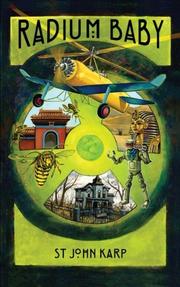


Radium Baby
by St. John Karp
In Karp’s debut young-adult novel, three preteens compete to prove their connection to famous scientists who died more than a decade ago.
In 1927, 13-year-old Sam Ticky lives in Claremore, Okla., also known as “Radium Town,” because the chemical element bubbles freely from the ground, like oil. He works at the radium baths, where people soak in an effort to cure themselves of ailments such as barnacles and gout—despite the fact it might possibly be dangerous. According to Sam’s adoptive father, Sam is the biological son of the well-known scientists Alexander and Valerie Pepperpot, who gave him up after they died; as a result, science is his heritage. Meanwhile, in New York, Clive Chapman ponders the fate of his Sun Studios Radio Corporation. Ratings are falling, even on his most popular shows, and he needs something brilliant to turn his business around. When the U.S. government asks for his help in finding the Pepperpots’ missing child, he dreams up a contest. Soon, Sam is competing against two other finalists who share his birthday, Gloria Noakes and Hadrian Sands. The prize: the Pepperpots’ estate. The contestants must solve a series of puzzles staged in China, Egypt and Boston as they try to provide proof of the identity of the real “Radium Baby.” Throughout this adventure novel, Karp’s madcap imagination keeps readers hungering for the final outcome, and his prose sparkles with his flair for the absurd: For example, the Pepperpots “invented the hamster wheel, the hamster cage and the hamster feeder, then rounded off their list of achievements by inventing the hamster.” The contest’s puzzles, which involve such diverse elements as hornets’ honey and the Eye of Tutankhamen, have surprise twists, but Karp isn’t merely a showman. He’s also capable of dreamily evocative scene-setting (“Everything hit [Sam] at once...the temples with roofs like dog-eared paper, [and the] fine statues and filigree metalwork tracing spider webs across the walls and ceilings”) and manages to end his tale on a truly profound note.
A devilishly rich, satisfying scientific confection.